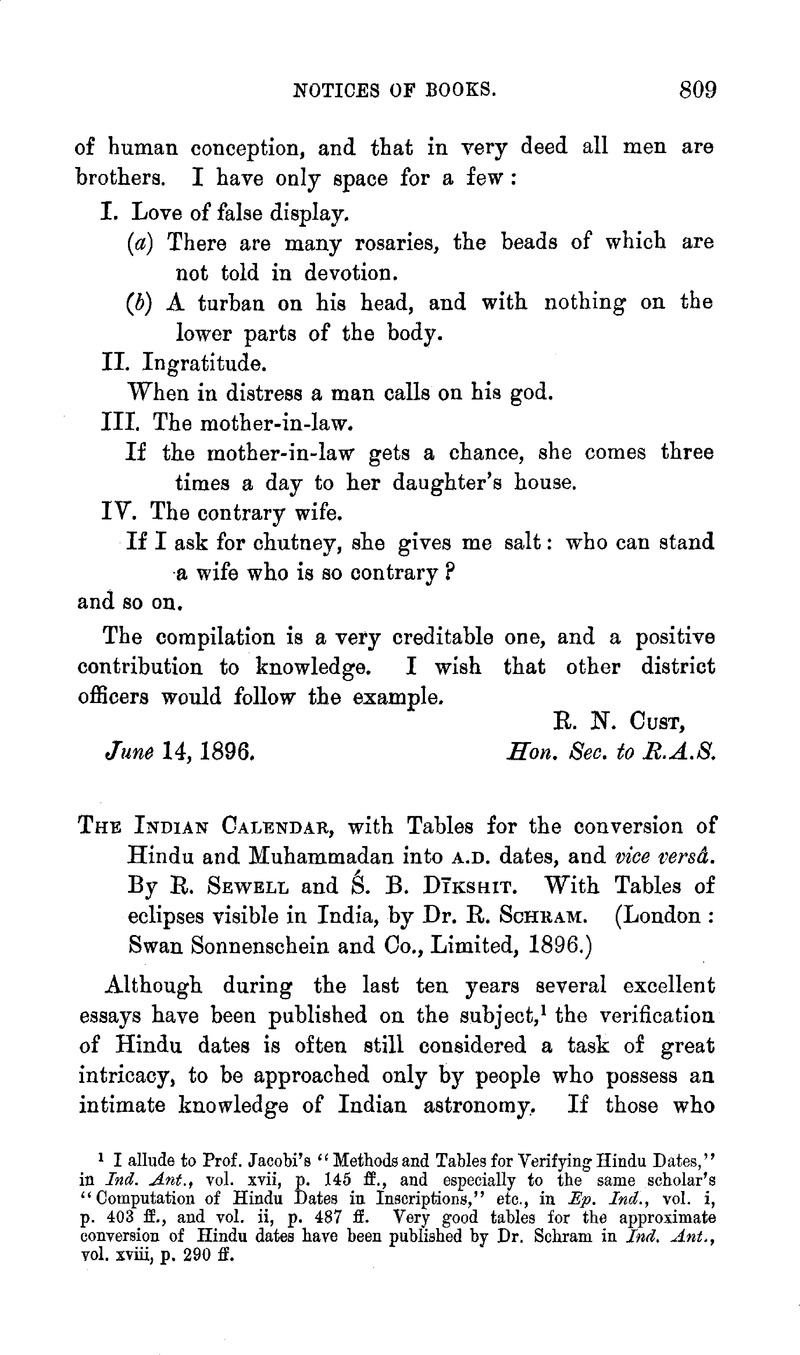No CrossRef data available.
Article contents
Notices of Books - The Indian Calendar, with Tables for the conversion of Hindu and Muhammadan into A.D. dates, and vice versâ. By R. Sewell and Ś. B. Dīkshit. With Tables of eclipses visible in India, by DrR. Schram. (London: Swan Sonnenschein and Co., Limited, 1896.)
Review products
Published online by Cambridge University Press: 15 March 2011
Abstract

Information
- Type
- Notes of the Quarter
- Information
- Copyright
- Copyright © The Royal Asiatic Society 1896
References
page 809 note 1 I allude to Prof. Jacobi's, “Methods and Tables for Verifying Hindu Dates,” in Ind. Ant., vol. xvii, p. 145 ff.Google Scholar, and especially to the same scholar's “Computation of Hindu Dates in Inscriptions,” etc., in Ep. Ind. vol. i, p. 403 ff., and vol. ii, p. 487 ff. Very good tables for the approximate conversion of Hindu dates have been published by DrSchram, in Ind. Ant., vol. xviii, p. 290 ff.Google Scholar
page 812 note 1 Regarding the approximate method, the authors, on p. 65, say: “Results found by this method may be inaccurate by as much as two days, but not more. If the era and bases of calculation of the given Hindu date are clearly known, and if the given date mentions a weekday, the day found by the tables may be altered to suit it.” But “the bases of calculation” of a given date can never be known until a date has been accurately verified; and that one should alter the day found by the tables so as to suit a given weekday, I consider rather dangerous advice.
page 812 note 2 Although the dates which employ the principal Hindu eras commonly give expired years—dates of the Vikrama era do so nearly always, and for every S'aka date with a. current year we have about four S'aka dates with expired years—the authors in their tables throughout have given current years. How, from a practical point of view, they may justify this, I do not know; but I am the more surprised at their procedure because, judging from the notes on pp. 40 and 42, they are inclined to look on the Vikrama years of the dates and on the “so-called expired S'aka years” as current years (not the current years of their tables).
page 813 note 1 Our authors on p. 27 say that the change from the mean to the true system of intercalation took place about a.d. 1040. But my examination of dates has shown to me that in practice the change had taken place already in the beginning of the 10th century a.d.
page 814 note 1 The number 63 under d denotes the 63rd day of a.d. 1223; the 0 under w denotes the weekday Saturday (Sunday being counted as 1, Monday as 2, etc., and Saturday as 7 or 0). The figures under a, b, and c give certain quantities from which the condition of the tithi at sunrise is ascertained, a being corrected by the equations for band e, taken from Tables VI and VII. In adding up the numbers under b and e, thousands are omitted; in adding up those under a, ten-thousands.
page 815 note 1 These figures for a, b, and e, again, are exactly the same as those found by Prof. Jacobi's tables for the 26th February, a.d. 1120.
page 815 note 2 The exact time of the end of the tithi, calculated according to the new tables, was 19 h. 56 m. after mean sunrise, but for ordinary purposes it is unnecessary to calculate this, because t = 8360 sufficiently shows that the 26th February, A.D. 1120, under any circumstances was the Uth of the dark half.

